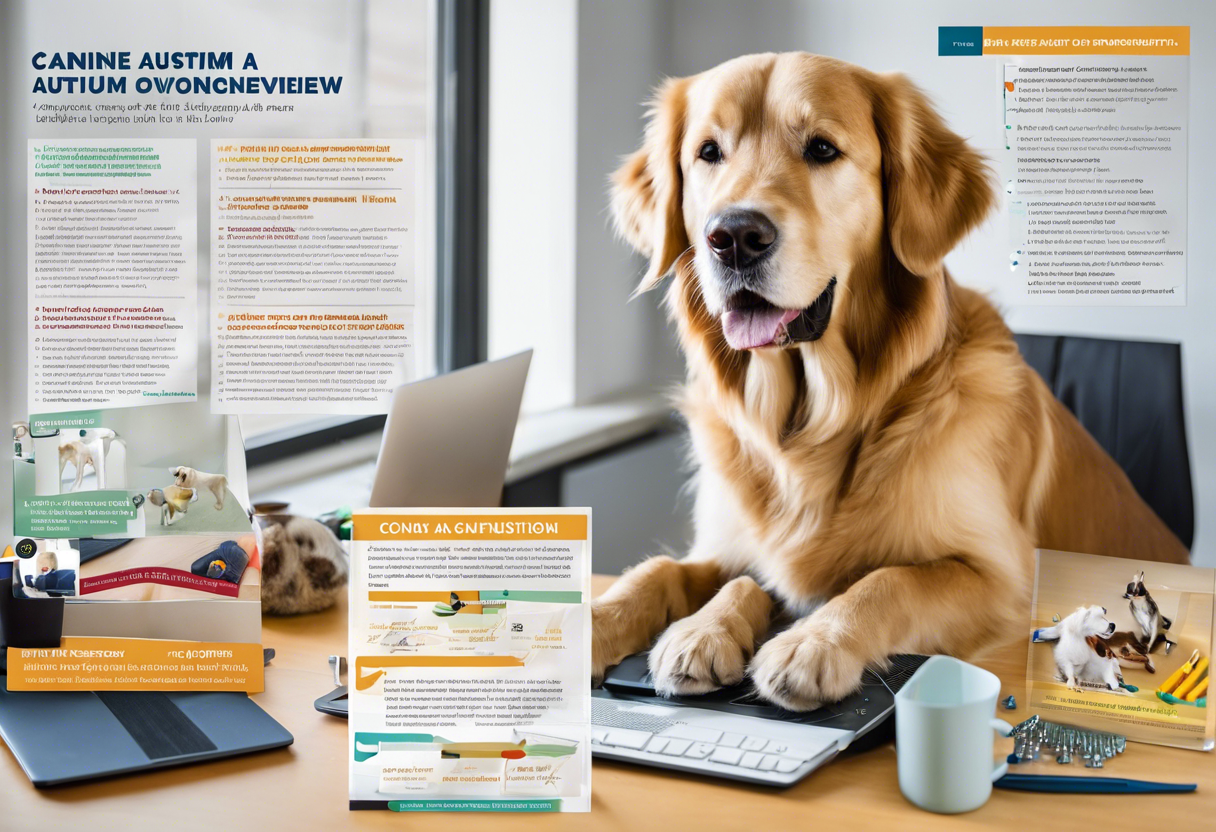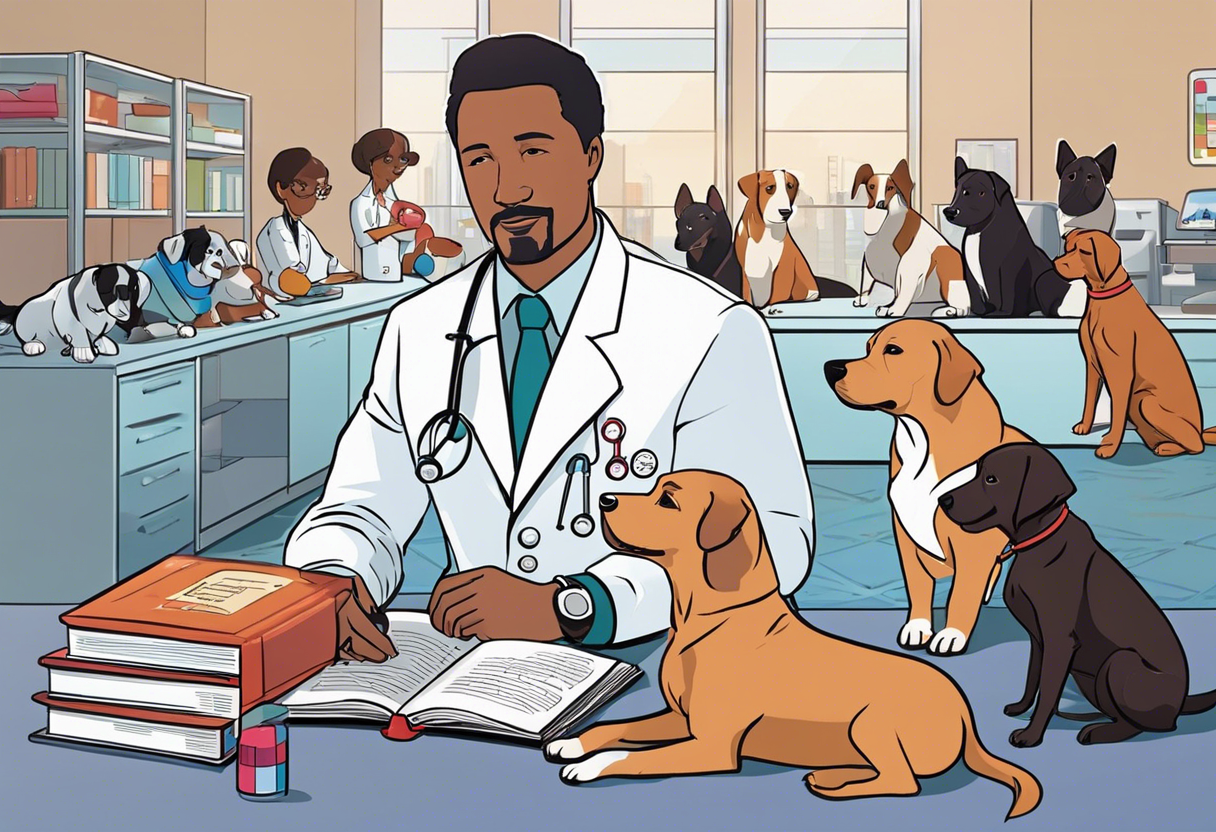Here’s an overview:
-
Therapeutic Interventions: Available Treatments and Supports
-
The Role of Diet and Nutrition in Managing Canine Behavioral Issues
-
Community and Support: Navigating Challenges with Other Dog Owners
-
Perspectives from Veterinary Experts on Canine Behavioral Challenges
Introduction to Autism in Dogs

When exploring the realm of canine behavioral issues, the concept of autism in dogs emerges as a subject of increasing interest and debate among veterinarians, behaviorists, and pet owners alike. Although autism is a well-documented neurodevelopmental disorder in humans, characterized by challenges with social skills, repetitive behaviors, and communication issues, its existence in dogs is not officially recognized or diagnosed in the same way.
The potential comparison arises from observing behavioral patterns in dogs that mirror those typically associated with autism spectrum disorder in humans. In canines, such patterns may manifest as difficulties with social interaction, a resistance to change in routines or environment, and a penchant for repetitive motions or activities. There is no consensus within the scientific community regarding whether these behaviors are indicative of a canine variant of autism, or if they represent a unique set of conditions not directly related to the human condition.
Investigating supposed autistic-like behaviors in dogs involves thorough behavioral assessments by professionals. Signs potentially associated with these atypical behaviors include:
-
Limited or no desire to interact with other dogs or humans.
-
High sensitivity to sensory stimuli such as sounds, smells, or touch.
-
Developmental delays, especially in understanding and performing tasks.
-
Repetitive motions such as persistent tail-chasing or pacing.
-
Preference for sameness and routine, with distress evident when changes occur.
As research progresses, the concept of canine autism must be approached with scientific rigor and open-mindedness. The primary objective remains to enhance the lives of dogs exhibiting these behaviors through improved understanding, appropriate management strategies, and compassionate care, rather than to exclusively label or diagnose as seen in human medicine. This introduction serves merely as a starting point for the broader discussion and exploration of the phenomena of autism-like behaviors in the canine population.
What is Canine Autism: A Comprehensive Overview

The concept of canine autism revolves around a behavioral syndrome that exhibits symptoms similar to those of human autism spectrum disorder (ASD). Although not officially recognized in the Diagnostic and Statistical Manual of Mental Disorders (DSM) for animals, the idea has gained traction among veterinarians and animal behaviorists who’ve noted analogous patterns in dogs.
Key Characteristics of Suspected Canine Autism:
-
Repetitive Behaviors: Dogs suspected of having autism might display repetitive actions, akin to the repetitive behaviors seen in humans with ASD.
-
Social Challenges: Affected canines could show difficulties in social interaction with other dogs and humans, including a lack of interest in social play or engagement.
-
Communication Issues: Similar to humans with autism, dogs might have trouble understanding or expressing social cues—both verbal and non-verbal.
-
Developmental Anomalies: Developmental milestones may be missed or notably delayed.
-
Sensory Sensitivities: Heightened sensitivity or indifference to sensory stimuli can be a sign, with some dogs reacting strongly to sounds or textures, while others may appear under-responsive.
Potential Causes:
-
Genetic Factors: There is a possibility that genetics contribute to canine autism, although research is ongoing and no specific gene has been identified.
-
Environmental Influences: Certain environmental factors during prenatal development, such as exposure to toxins or viruses, could potentially predispose a dog to autism-like behaviors.
Diagnosis:
Diagnosing a dog with autism is challenging due to the subjective nature of behavioral assessment and the lack of established criteria. Veterinarians may employ a combination of observational techniques and exclusion of other medical conditions to reach a tentative diagnosis.
While the term ‘canine autism’ is subject to debate and requires more scientific validation, recognizing and understanding these atypical behaviors is crucial for providing proper care and improving the quality of life of dogs exhibiting these traits.
Recognizing Autism in Dogs: Signs and Symptoms

Autism in dogs, albeit not officially diagnosed as in humans, can manifest through a variety of behavioral signs and symptoms. It is crucial for dog owners and veterinarians to be observant of these indicators, as they can significantly affect a dog’s ability to interact with its environment and can influence their overall well-being.
-
Repetitive behaviors: Dogs displaying signs of autism may engage in repetitive actions, such as spinning, tail-chasing, or obsessive licking of surfaces or themselves.
-
Resistance to change: Dogs with this condition might show considerable distress or discomfort when their routine is altered or if they are introduced to new environments or individuals.
-
Social challenges: Affected dogs might struggle with social interactions, appearing aloof or indifferent towards other dogs or people, and might not engage in play or seek affection as expected of typical canine behavior.
-
Sensory sensitivities: Dogs might exhibit unusual reactions to sensory stimuli. This can include extreme reactions to sounds, textures, or lights that do not seem to bother other dogs.
-
Irregular motor behaviors: Some dogs might display coordination issues, such as a peculiar gait or difficulty with complex movements that other dogs perform easily.
-
Communication difficulties: Dogs can display uncommon vocal patterns or may not use their voice as other dogs do. They might seem to have trouble decoding the body language and signals of their humans or canine companions.
-
Impaired learning ability: While not always present, some dogs with autism-like symptoms may have difficulty learning new commands or behaviors, or they may learn at a slower pace than their peers.
It is important to note that these behaviors alone do not necessarily indicate autism in dogs and could be symptomatic of other medical or behavioral issues. A comprehensive evaluation by a veterinary professional is essential for an accurate understanding of these behaviors.
The Science Behind Canine Autism: Genetics and Environment

Autism in canines, much like in humans, may stem from an intricate interplay between genetics and environmental factors. Scientific research into the realm of canine behavior and genetic markers has seen promising momentum in recent years, although definitive causes of autism-like symptoms in dogs remain elusive.
Genetics
At the genetic level, dogs share many chromosomal similarities with humans, which suggests the possibility of parallel conditions existing across species.
-
Geneticists have identified certain genes that are associated with neural development and social behavior.
-
Heritable factors are considered significant contributors to behavioral syndromes in dogs, potentially aligning with the human counterparts of these conditions.
-
Studies have implicated specific alleles, or variants of genes, that could influence the risk of developing symptoms often likened to autism spectrum disorder.
Environmental Factors
Environmental triggers are also believed to play a critical role in the development of autism-like behaviors in dogs.
-
Prenatal exposure to toxins or infections may alter normal brain development in puppies.
-
Stressful events or trauma experienced at a critical developmental stage may precipitate the onset of symptoms.
-
Poor socialization during the early weeks of life can impact a dog’s ability to interact with other dogs and humans, resembling the social challenges seen in autistic individuals.
The concept of canine autism remains a subject of ongoing study, with interdisciplinary efforts between veterinarians, behaviorists, and geneticists seeking to unravel the complexities of this phenomenon. Continued advancements in genetic testing and a deeper understanding of the canine brain will illuminate the full scope of behavioral conditions and their roots, moving toward tailored care and interventions for affected dogs.
Assessment and Diagnosis: Techniques and Challenges

Diagnosing behavioral conditions in dogs, including those likened to autism in humans, requires a multi-faceted approach. Veterinary behaviorists typically employ a variety of techniques to accurately assess canine behavior and determine an appropriate diagnosis.
Techniques for Assessment:
-
Behavioral History: An in-depth interview with pet owners to evaluate the dog’s complete behavioral history is crucial. This includes the onset of symptoms, potential triggers, and environmental changes.
-
Observation: Careful observation of the dog in various settings and situations helps to identify patterns and specific issues in the animal’s behavior. This can involve both in-home assessments and controlled environment observations.
-
Physical Examination: A full physical examination by a veterinarian can rule out medical issues that might be contributing to changes in behavior.
-
Neurological Assessments: Advanced diagnostics such as MRI or CT scans can sometimes be used to detect neurological anomalies that may be related to atypical behaviors.
-
Standardized Behavioral Tests: These tests facilitate the comparison of an individual dog’s behavior against established norms for canine behavior.
Challenges in Diagnosis:
-
Communication Barrier: Dogs cannot verbalize their feelings, making it difficult to fully understand their experiences and symptoms.
-
Absence of Standard Criteria: There is no universally accepted set of criteria for diagnosing autism-like conditions in dogs, making diagnosis subjective.
-
Complex Symptoms Overlap: Many behavioral issues share similar symptoms, which can make it challenging to differentiate between them.
-
Varied Reactions to Stress: Dogs respond differently to stress and clinical environments, which can affect their behavior during assessment.
Expertise in animal behavior, patience, and a systematic approach are vital to overcome these challenges and ensure an accurate assessment and diagnosis. Training and experience equip veterinarians and behaviorists to interpret subtle signs and differentiate between various behavior disorders. Despite the complexities, such assessments are key to providing appropriate interventions and improving the quality of life for dogs with behavioral challenges.
Debunking Myths: Understanding What Canine Autism Is Not

When it comes to understanding canine autism, or rather behaviors in dogs that may be likened to autism in humans, it’s crucial to clarify what this condition is not. The spread of misinformation can lead to misconceptions, making it harder for pet owners to correctly identify and manage their dogs’ behavioral challenges. Here, we tackle some common myths:
-
Myth 1: Canine Autism is a definitive medical diagnosis. Canine autism, as it is colloquially referred to, is not a recognized or diagnosable condition in veterinary medicine. The term is sometimes used to describe behaviors that resemble autistic traits in humans but lacks a scientific basis for a direct comparison.
-
Myth 2: Vaccinations cause autism in dogs. This myth mirrors an unfounded concern regarding human vaccinations. There is no scientific evidence supporting the claim that vaccinations lead to autism in dogs. Vaccines are crucial for preventing serious canine diseases and should not be neglected due to this misconception.
-
Myth 3: Autism in dogs can be cured. Since the idea of canine autism isn’t supported by a defined set of diagnostic criteria, talking about a cure is misleading. Behavioral challenges often have underlying causes that can be addressed with the help of a professional, but there is no catch-all cure for such issues.
-
Myth 4: Only purebred dogs exhibit autistic-like behaviors. Behavioral quirks or challenges are not confined to purebred dogs; they can appear in any breed or mix. Assuming only purebreds are affected may hinder the recognition of issues in mixed-breed dogs.
Addressing these myths is an essential step in fostering a better understanding of the behavioral challenges that some dogs face. It’s important to consult with a veterinarian or a veterinary behaviorist who can provide guidance based on scientifically-backed information and who can help figure out the best management or treatment approaches for a dog exhibiting atypical behaviors.
Managing Autism in Dogs: Training and Lifestyle Adjustments

When handling autism in dogs, it’s essential to implement specific training strategies and lifestyle adjustments that cater to a dog’s unique needs. Due to their condition, autistic dogs may require a highly structured environment and clear, consistent training methods.
-
Begin by establishing a predictable routine that reduces stress and anxiety. Regular feeding times, walks, and play sessions can create a sense of security.
-
Adapt your training techniques to your dog’s specific sensitivities. Use positive reinforcement, like treats or praise, and avoid harsh corrective measures that could cause further distress.
-
Gradually introduce new stimuli in a controlled way to help them adjust without becoming overwhelmed. Socialization should be done slowly, with close attention paid to the dog’s comfort level.
-
Create a quiet, safe space for them to retreat to when they are feeling stressed or overstimulated, akin to a den where they can feel secure.
-
Work closely with a veterinarian or a dog behavioral specialist to tailor a plan suited for your dog’s needs. They may recommend specific exercises or therapies that can improve symptoms.
-
Consider integrating sensory play which may include activities like sniffing games that can help autistic dogs engage with their environment.
-
Be patient and understanding, recognizing that progress may be slow and incremental.
All these steps should lead towards a comfortable lifestyle for both the autistic dog and their caregiver, with potential improvements in the dog’s ability to cope with everyday challenges.
Therapeutic Interventions: Available Treatments and Supports

When addressing autism in dogs, therapeutic interventions focus on alleviating symptoms and improving quality of life. There is no cure for autism, whether in humans or canines, but supportive treatments and strategies are utilized to manage behaviors. Here are some of the available treatments and supports:
-
Behavioral Modification: Training programs tailored to individual needs can be helpful. This may include consistency in routine, positive reinforcement techniques, and desensitization exercises to reduce anxiety related to sensory sensitivities.
-
Environmental Adjustments: Creating a safe and structured environment for an autistic dog is crucial. This could involve reducing exposure to overwhelming stimuli and providing spaces where the dog can retreat to feel secure.
-
Sensory Enrichment: Sensory toys and activities that stimulate the dog’s senses in a controlled manner can enhance their coping skills. For instance, toys with different textures or sounds help them to process sensory information more effectively.
-
Medical Interventions: In some cases, veterinarians may prescribe medications to manage symptoms such as anxiety or aggression. However, this is generally considered after other non-pharmacological interventions have been attempted.
-
Alternative Therapies: Techniques such as massage, acupuncture, or aromatherapy might provide relief from stress and improve overall well-being. These are typically used in conjunction with other treatments.
-
Support Networks: Providing support for the caregivers is also an integral part of the therapeutic intervention. Support groups, educational resources, and professional advice can assist owners in managing their dog’s condition.
-
Diet and Nutrition: Consultation with a veterinarian about the dog’s diet can be important, as certain ingredients might influence behavior. A balanced diet is essential for the dog’s physical and mental health.
Each dog will respond differently to these interventions, and what works for one dog may not work for another. A multidisciplinary approach often yields the best results, and professional guidance from a veterinarian or a dog behaviorist is recommended to tailor an appropriate plan for each individual dog.
Creating an Autism-Friendly Environment for Your Dog

Ensuring that a dog with autism thrives requires a living space that caters to its unique sensory needs. Owners can foster a sense of safety and comfort for their canine companions by paying attention to the following aspects:
-
Routine and Predictability: Keep a consistent schedule for meals, walks, and playtime. Dogs with autism may become stressed by unpredictable changes.
-
Safe Spaces: Designate a quiet area where the dog can retreat. This could be a cozy corner with a soft bed and favorite toys, away from the hustle and bustle of the household.
-
Controlled Sensory Input: Limit exposure to overwhelming stimuli. Be mindful of loud noises, bright lights, and high foot traffic areas. Use thick curtains, padded flooring, or white noise machines if necessary.
-
Gentle Handling: Interact with the dog in a calming manner. Abrupt movements and loud voices can be disconcerting. Instead, use a soft tone and move slowly.
-
Positive Reinforcement: Reward desired behaviors with treats, praise, or gentle petting to build confidence and a sense of achievement.
-
Customized Interaction: Recognize the dog’s individual preferences whether they involve more tactile interaction or a preference for minimal touch.
-
Clear Communication: Use simple, consistent commands during training sessions to avoid confusion.
Providing an autism-friendly environment is a dynamic process. Owners should observe their dogs’ reactions and adjust the surroundings as needed to create a supportive and stress-minimizing living space.
The Role of Diet and Nutrition in Managing Canine Behavioral Issues

Diet and nutrition play crucial roles in maintaining the overall health of a dog, which inevitably influences their behavior. While the concept of autism in dogs is not clearly defined or recognized in veterinary medicine, dietary management can be significant in addressing various canine behavioral challenges that may resemble autism-like symptoms.
-
Certain food ingredients can trigger adverse reactions in dogs, such as allergies or intolerances, potentially leading to behavioral changes like irritability or aggression.
-
Proper nutrition supports optimal brain function. Deficiencies in essential nutrients like omega-3 fatty acids, vitamins, and minerals can lead to cognitive dysfunction, affecting behavior and the ability to learn or adapt to new situations.
-
Incorporating a stable routine with regular feeding times can help reduce anxiety and provide a sense of security for dogs with behavioral issues.
-
High-quality protein sources are necessary for maintaining a balanced mood and preventing sudden energy spikes that can exacerbate hyperactivity or impulsivity.
For dogs exhibiting signs of behavioral challenges, it is recommended to consult with a veterinary nutritionist or a behaviorist. They can suggest a tailored diet plan to address specific issues, which might include:
-
Eliminating potential allergens and slowly reintroducing foods to identify triggers.
-
Adding supplements to address any nutritional deficiencies.
-
Adjusting the proportion of macronutrients to better suit the dog’s individual needs, potentially reducing the intake of carbohydrates and increasing high-quality proteins and fats.
-
Implementing a novel protein diet if food sensitivities are suspected, which includes the use of proteins that the dog has not been exposed to before.
It is essential to approach dietary adjustments with care and monitor the dog’s response to determine if dietary changes are having a positive effect on their behavior.
Community and Support: Navigating Challenges with Other Dog Owners

Being a caretaker of a dog with autism can be a complex and isolating journey. Fortunately, there are communities and support systems in place to assist dog owners in navigating these challenges. Engaging with a network of individuals who understand the unique struggles can be a source of immense relief and practical advice.
-
Finding a Support Group: Seek out support groups specifically for owners of dogs with behavioral challenges. These groups can provide emotional support, share experiences, and offer problem-solving strategies that have worked for others in similar situations.
-
Online Forums and Social Media: Online communities can be a treasure trove of information. Platforms like Facebook, Reddit, and dedicated pet forums contain threads and groups where owners discuss their experiences and offer insights into living with dogs that have autism-like behaviors.
-
Veterinary Behaviorists: Consulting a veterinary behaviorist can be invaluable. These professionals specialize in animal behavior and can offer guidance tailored to a dog’s specific issues. They also understand the science behind the behavior, which can help in crafting effective management and training strategies.
-
Educational Workshops: Participate in workshops and seminars on canine behavior. These events often feature experts in the field and provide an opportunity to learn more about dog behavioral health while connecting with other owners facing similar challenges.
-
Local Meetups: Organize or join local meetups with other dog owners. Sharing experiences in person can lead to friendships and a local support network that understands the complexity of caring for a dog with special needs.
Remember, every dog is unique, and what works for some may not work for others. Therefore, it is crucial to be patient and open-minded while exploring various support systems. They not only offer a wealth of knowledge and moral support but also remind owners that they are not alone on this journey.
Perspectives from Veterinary Experts on Canine Behavioral Challenges

Veterinary experts have significantly contributed to the understanding of canine behavioral challenges that may present as symptoms akin to autism in humans. They emphasize that while there is not a direct diagnosis of autism in dogs, certain atypical behaviors warrant focused attention and a nuanced approach.
-
Complexity of Diagnosing Behavioral Issues: Diagnosing atypical canine behaviors is complex and requires a multi-faceted approach. Veterinary experts advocate for comprehensive evaluations that include a dog’s medical history, genetic predispositions, and environmental factors. This broad perspective is crucial for addressing behavioral issues accurately.
-
Importance of Early Intervention: Early recognition and intervention are essential in managing canine behavioral challenges. Experts encourage dog owners to seek guidance as soon as they notice persistent behavior changes. Early intervention strategies might include behavioral modification techniques, environmental enrichment, and in some cases, pharmacotherapy.
-
Role of Socialization: Proper socialization during a puppy’s developmental stages is highlighted as a critical factor in preventing future behavioral challenges. Veterinary professionals stress the importance of exposing puppies to various stimuli and social situations to mitigate the risk of developing extreme responses to stimuli later in life.
-
Potential for Misdiagnosis: There is concern over the possibility of misdiagnosing behavioral issues due to a lack of understanding of a dog’s normal behavior. Veterinary behaviorists underline the need for precise observation and interpretation of canine behaviors to prevent attributing normal canine responses to potential pathological conditions mistakenly.
-
Considering the Whole Animal: Experts consider the ‘whole animal’ approach vital when assessing behavioral challenges. This perspective integrates behavioral assessments with physical health evaluations, acknowledging that what may manifest as a behavioral problem could be rooted in a physical aility.
Veterinary experts unite in the idea that behavioral challenges in dogs, reminiscent of autistic-like symptoms, require a sophisticated and empathetic approach. Collaboration between veterinarians, behavioral specialists, and dog owners is key to developing effective management plans tailored to each individual dog.
Beyond the Diagnosis: The Life and Care of Dogs with Autism

When a dog is diagnosed with canine autism, it marks the beginning of a nuanced journey for both the pet and its owner. Understanding and adjusting to the peculiarities of autistic dogs is essential to their health and happiness.
-
Dogs with autism may exhibit repetitive behaviors, social detachment, and hypo- or hypersensitivity to sensory stimuli.
-
Consistent routines provide a sense of security for autistic dogs, helping to minimize stress and anxiety.
-
Owners should take care to slowly introduce new experiences, allowing the dog to adjust at its own pace.
-
Sensory enrichments, like calming music or textured toys, can be beneficial, though one must carefully observe the dog’s reactions.
-
Training methods for dogs with autism should be gentle and reward-based, focusing on positive reinforcement rather than punishment.
Socialization poses unique challenges and requires a delicate balance:
-
Introduce other animals or people cautiously and supervise interactions to ensure comfort for all involved.
-
Professional guidance from vet behaviorists or trainers experienced with autism in dogs can be invaluable in devising customized care strategies.
Healthcare for dogs with autism may necessitate special considerations:
-
Veterinary visits should be low-stress experiences, possibly with accommodations such as quiet rooms or less crowded appointment times.
-
A balanced diet, regular exercise, and mental stimulation are foundational to maintaining an autistic dog’s well-being.
Ultimately, the ownership of an autistic dog is a deeply personal and evolving experience. It demands patience, empathy, innovation, and the unconditional love that all canines, regardless of their neurological makeup, rightfully deserve. By adopting a mindful approach to their care, autistic dogs can lead fulfilling lives, and their human companions can enjoy a profound, enriching bond with their loyal friends.
Conclusion: Embracing the Uniqueness of Autistic Dogs
Understanding autism in dogs requires a shift in perspective and a commitment to empathy. These unique canines offer a rich opportunity to expand our knowledge and challenge the conventional interpretations of dog behavior. It’s crucial to recognize that dogs with autism may experience the world in ways we are still striving to comprehend.
The journey of living with an autistic dog can be both demanding and rewarding, demanding because it requires patience, consistency, and a willingness to learn and adjust. Rewarding, because it allows owners to form deep, meaningful bonds based on mutual respect and understanding. It reminds us that every dog, regardless of neurological condition, deserves love and a quality life.
Professionals and pet owners are encouraged to:
-
Continue research to better understand canine autism, improving diagnostic criteria and treatment strategies.
-
Develop supportive environments where these dogs can thrive, maximizing their comfort and well-being.
-
Promote awareness about canine autism, preventing misconceptions and encouraging acceptance within the pet community.
-
Share success stories to inspire those living with autistic dogs, highlighting the individual achievements and breakthrough moments.
By embracing the uniqueness of autistic dogs, we foster an inclusive society that values the diversity of life. These dogs, like all animals, have their own contributions and joy to bring into our lives. Celebrating their distinctiveness not only enhances their lives but also enriches our own, teaching us invaluable lessons in compassion and unconditional love.




